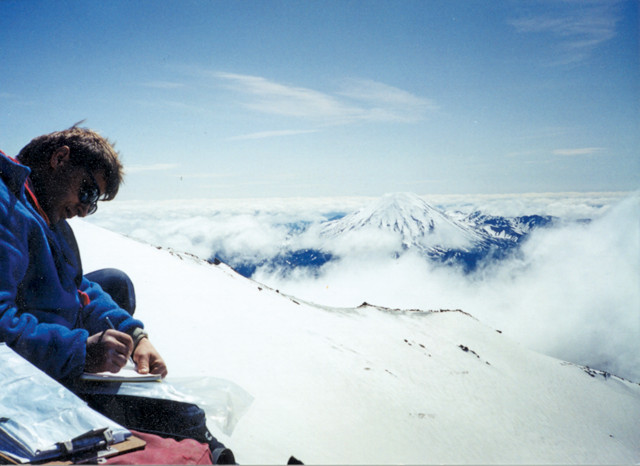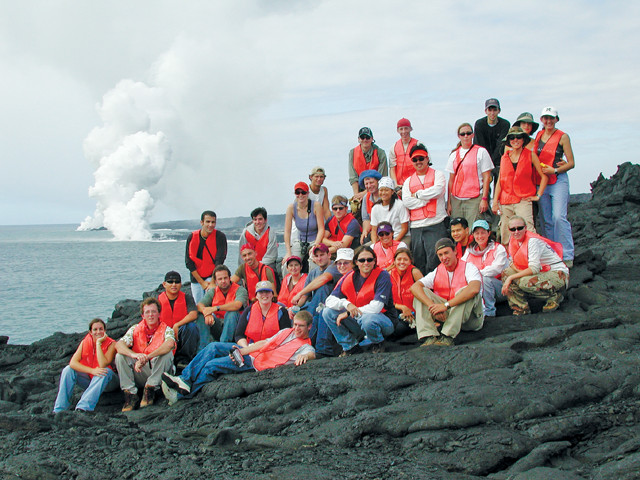
by Mary Caperton Morton Friday, August 31, 2018

Thordarson studies the 1995–96 eruption of Mount Ruapehu in New Zealand, where he witnessed the beginning phases of the eruption from a helicopter above the crater. Credit: courtesy of Thor Thordarson.
Despite growing up in Iceland, with Earth’s most volcanically active landscape as his playground, Thorvaldur Thordarson had no idea he would grow up to be a volcanologist. Nor did he suspect that his career path would take him all over the world to witness eruptions and aftermaths on six continents.
In 1964, when he was just 6, Thordarson witnessed his first volcanic eruption — the birth of the island of Surtsey off Iceland’s southern coast. Today, he credits his lifelong love of the outdoors for leading him to study geology. After graduating with a bachelor’s in geology from the University of Iceland, Thordarson earned a master’s degree in volcanology at the University of Texas at Arlington and a doctorate in volcanology from the University of Hawaii at Manoa.
These days, Thordarson splits his time between Iceland and his second volcanic home in Hawaii. He teaches at the University of Iceland in Reykjavik and is affiliated with the University of Hawaii at Manoa, where his research encompasses many diverse aspects of volcanology and petrology, including volcanic processes, the physics and mechanics of all types of eruptions, the short- and long-term effects of volcanism on climate, and how volcanism can be harnessed for geothermal power.
Thordarson spoke with EARTH about why a volcanologist would ever leave Iceland, what he misses most about his subarctic homeland when he’s living in Hawaii’s tropical paradise, and the one exotic volcanic setting that is still on his life list.
MCM: Did growing up in Iceland help spark your interest in volcanoes?__
TT: I’m sure, deep in my subconscious mind, that my interest in volcanoes goes back to childhood, but as a kid, there was never a thought that I wanted to be a volcanologist. I didn’t know such a job existed until much later. Volcanoes are a part of life in Iceland. If childhood exposure to volcanoes made kids grow up to be volcanologists, everybody in Iceland would be a volcanologist!
I started my university studies in the physics department because I liked science and wanted to do experiments, but I soon realized I didn’t want to spend all my time indoors, or wear a white lab coat, so I started looking for a career that would take me outside. I chose geology because it had the greatest number of field trips! I quickly became enamored with looking at rocks in detail. I’m continually amazed how much you can learn about Earth’s history just by studying rocks.
MCM: What was the first volcano you studied as a scientist?__
TT: My first research project was on the Laki eruption of 1783–84 (supervised by Gudrún Larsen and Sigurdur Steinthorsson). Getting to the site is quite an adventure, requiring many miles of driving on a very rough, remote road. I drove my old truck up there in 1983 — 200 years after the eruption. I arrived at the vent area at 11 o’clock at night, which in Iceland in early August is right around sunset. I came over a hill and suddenly I could see all the cones on the Laki fissures stretching to the horizon, all bathed in the red glowing evening sun — that was it for me, the search was over. Volcanoes had captured my mind and soul and I’ve spent the rest of my life figuring out why they do what they do.
MCM: Iceland is the most volcanically diverse place on Earth. As a volcanologist, why go anywhere else?
TT: When I finished my undergraduate degree, at the time, the only way to get a graduate degree was abroad. So, I went to the University of Texas at Arlington for a master’s in volcanology under the supervision of Stephen Self and John A. Wolff, which turned out to be a very fruitful experience in ways I didn’t anticipate. It opened my eyes, and my perception of volcanology as a field became much more dynamic as I realized how important it is to be exposed to new ways of doing research, as well as to new cultures and new landscapes, volcanic and otherwise. For example, I had the opportunity to go to Australia to study very old rocks from the Archean, which date back 2.5 billion to 3.5 billion years ago. The amazing thing is that, even though these ancient rocks have been metamorphosed and recrystallized, the original volcanic texture of the rocks is still well preserved, and you can learn a lot about their origin, history and formation just by analyzing those textures. I was amazed to see that you could learn so much from very old rocks. Before going to Australia, I had only worked on relatively young, fresh rocks. It really makes you realize that the same processes have been operating on Earth for a very, very long time.

Thordarson (upper middle in blue hat) with the volcanology class of Bruce F. Houghton, professor of volcanology at the University of Hawaii at Manoa, in front of one of Kilauea's ocean entries in 2001. Credit: courtesy of Thor Thordarson.
MCM: What took you to Hawaii?
TT: I always thought I’d get my master’s and then go back home to Iceland, but I got drawn into such an exciting world of research that I wanted to get my doctorate. I applied for and was awarded a Global Change Research Fellowship through NASA [the fellowship is now discontinued] and got to pick which university I wanted to attend. So I went to the University of Hawaii at Manoa, where I studied under the principal supervision of Stephen Self (who had relocated to Hawaii) and George Walker, who is considered by many to be the father of modern-day volcanology. Of course, the volcanology program at the University of Hawaii was an attractant, but I was also very curious about Hawaii itself. I had never been to the tropics. It turned out to be an exceedingly interesting place in so many ways, especially culturally. Hawaii was the first place I ever lived where whites were the minority, which was a very enlightening experience for me. The Hawaiian people are amazingly tolerant and accepting of other cultures and traditions, and this acceptance extends to natural events as well, including volcanic eruptions. Hawaii is also where I met my wife, so it’s a very special place for me.
MCM: How do cultural attitudes toward volcanic eruptions compare between Hawaii and Iceland?
TT: Both Iceland and Hawaii are volcanically active islands, where you can’t run away from the effects of volcanism. You have to figure out how to live alongside active volcanoes. I’m fascinated by how native Hawaiians view volcanic eruptions as expressions of the fire goddess Pele and as almost sacred events. They view Pele not just as a god, but part of their extended family. It’s a very intimate relationship that enables them to live with nature, even at its most destructive. Hawaiians are very resilient; rebuilding is a part of life.
In Iceland, we have a similar accepting relationship with volcanoes but it’s more like resignation, not as much celebration. In Iceland we don’t tie volcanoes to any mythological figure, it’s just a natural phenomenon, something you have to deal with, which I suppose is the colder, more logical approach. In the past, European authorities often tried to use natural disasters as a way of controlling the public, saying God is punishing you for not obeying us or being wicked in some way. But that tactic never worked in Iceland. Volcanic eruptions affected everybody equally, not just peasants or certain groups of people. We were all in it together.

Thordarson cooling his rock hammer after sampling a fresh lava flow from Kilauea in Hawaii in 2005. Credit: courtesy of Thor Thordarson.
MCM: What do you miss most about Iceland when you are in Hawaii? And vice versa?
TT: I miss the long summer days, the midnight sun, and the Icelandic highlands, my favorite place to recharge. Of course, I miss the climate of Hawaii, where temperatures are perfect for enjoying outdoor activities year-round. When I’m in Hawaii, I tend to spend my free time in the mountains, rather than on the beaches. I feel very fortunate to travel between the two places frequently. Hawaii has become my second home.
MCM: What is the most memorable eruption you have witnessed in your career?
TT: Each eruption is memorable for different reasons: Some you learn a lot from by direct observation and by interaction with other fellow researchers, others are just incredibly dramatic to witness. The 1995–96 eruption at Ruapehu Volcano in New Zealand is especially memorable because we were able to witness the beginning phases of the eruption from a helicopter above the crater — quite an incredible perspective of a rarely seen part of an eruption. The ongoing eruption of Kilauea always intrigues me because we don’t really know why it’s so continuous. What has been driving the volcano to erupt continuously for so long, since 1983? In many ways, Kilauea has played such a huge role in my education as a volcanologist. I owe a lot to it — it’s very special to me.
MCM: If you could have been around to safely witness any historical volcanic eruption, which would you choose?
TT: Of course, I would want to witness the 1783–84 eruption of Laki! To see all those vents and tephra cones opening and forming along a 27-kilometer-long fissure must have been an incredible sight. I’d also be interested to see if my interpretations about the eruption are correct. That volcano has many interesting stories to tell. To be clear, the last thing I would want to see happen in today’s world would be a Laki-like eruption, because it would impact our society on a hemispheric scale.
MCM: Are there any volcanoes still on your wish list to study?
TT: I’ve been very fortunate to study volcanoes and volcanic rock sequences on every continent, except Africa. I would love to go to Ethiopia and Kenya to see the East African Rift. That place is definitely at the top of my bucket list.
© 2008-2021. All rights reserved. Any copying, redistribution or retransmission of any of the contents of this service without the expressed written permission of the American Geosciences Institute is expressly prohibited. Click here for all copyright requests.